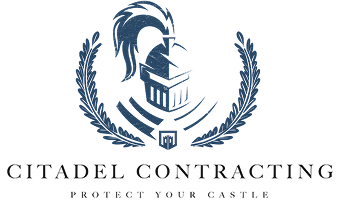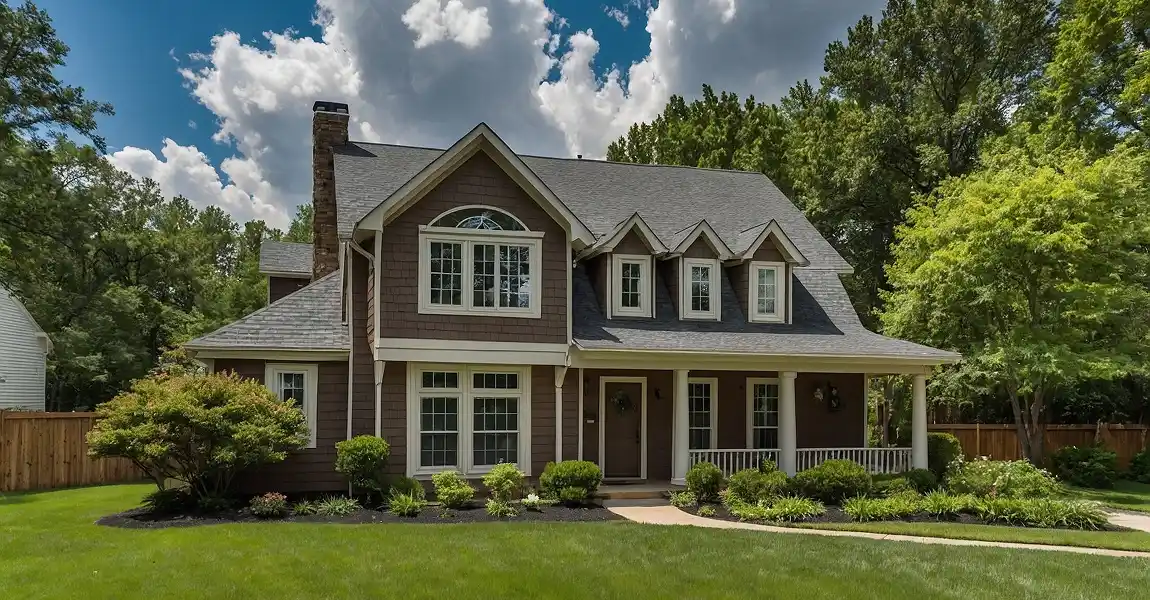There’s something special about driving through Raleigh’s Historic Oakwood District or strolling down the streets of Wilmington’s downtown. The intricate woodwork, the steeply pitched roofs, the timeless charm—it’s like stepping back in time. But those beautiful historical roofs don’t maintain themselves. They require care, patience, and a deep respect for traditional craftsmanship.
At Citadel Contracting, we’ve had the privilege of restoring some of these roofs. And let me tell you, historical roof restoration comes with its fair share of challenges. If you own an older home, here’s what you should know about the hurdles—and the rewards—of restoring a historical roof in North Carolina.
Finding materials that match the original roof
The first challenge? Finding the right materials. We’re not talking about grabbing a bundle of shingles from the hardware store. Historical roofs were often built with materials sourced from quarries, mills, and forges that no longer exist.
What makes material sourcing difficult:
- Slate from long-closed North Carolina quarries
- Hand-split cedar shakes with irregular textures
- Clay tiles made by artisans using molds that haven’t been seen in decades
Take one project we handled in Raleigh’s Boylan Heights. The home had a roof with unique clay tiles—terra cotta with a weathered finish. We tracked down a small manufacturer in Georgia that still uses traditional kiln-firing methods to achieve the right texture. It took time and patience, but the results were worth it. For anyone facing this challenge, expect to do some detective work.
Keeping the structure sound without changing the character
Historical roofs were often built on wooden frameworks that have been through decades of weather and wear. Modern roofing materials are heavier than the ones used in the past, so reinforcing the structure becomes necessary. But the challenge lies in doing that without altering the roof’s historical appearance.
What structural issues do we find most often?
- Rafters weakened by moisture or pests
- Ridge lines sagging from years of settling
- Unstable sections where repairs were done improperly in the past
We worked on a 1910 home near Mordecai Historic Park in Raleigh. The roofline had a noticeable dip, and we discovered water damage had weakened several beams. We installed steel braces behind the original wood, preserving the home’s look while ensuring the roof could handle the weight of new slate tiles. Structural integrity is critical, but so is keeping the charm intact.
Following historical preservation rules in North Carolina
If your home is in a designated historical district, you’ll quickly learn that you can’t just hire a roofer and start replacing shingles. Historical commissions across North Carolina have guidelines in place to protect these properties’ original character.
Here’s what that involves:
- Applying for permits specific to historical properties
- Using materials and designs approved by the commission
- Scheduling inspections at key points in the project
Raleigh’s Historic Oakwood District is one area where these rules apply. We once helped a homeowner get approval to restore their slate roof. The commission required us to use natural slate that matched the original color and texture. We worked closely with them throughout the process to ensure compliance. If you’re planning a Historical Roof Restoration, start the permitting process early—it saves a lot of headaches.
Repairing damage caused by decades of weather exposure
North Carolina’s weather is tough on roofs. Hot summers, sudden thunderstorms, winter ice—historical roofs see it all. And because many were built without modern moisture barriers, water damage is a frequent problem.
Common weather-related damage we encounter:
- Wood rot from trapped moisture
- Rusted flashing around chimneys and vents
- Tiles shifting or cracking due to freeze-thaw cycles
In one downtown Raleigh home, we found moss growing between the slate tiles. Beneath it? Rotted underlayment and rusted nails. We replaced the damaged layers, treated the wood to prevent future growth, and restored the roof with salvaged slate tiles. Weather damage doesn’t stop with what you see on the surface—it’s often what’s hidden that causes the most trouble.
Integrating modern technology without disrupting the historical look
Older roofs weren’t built with modern insulation or ventilation systems in mind. As a result, many historical homes suffer from high energy bills or poor attic airflow. The challenge is to add modern functionality without altering the roof’s historical appearance.
How we add modern efficiency without changing the look:
- Installing ridge vents that blend with the existing roofline
- Using breathable underlayment for moisture control
- Replacing old flashing with custom-shaped copper to match the original style
We worked on a home in Raleigh’s Glenwood-Brooklyn district that had an attic hotter than a summer sidewalk. By adding ridge vents designed to mimic the existing trim, we improved ventilation while preserving the roof’s vintage appearance. Now the attic stays cooler, and the HVAC system works less hard.
Finding craftsmen skilled in traditional roofing techniques
Historical roofs were crafted with care, often by hand. Replacing or restoring these roofs requires similar skills—but those skills are becoming increasingly rare. Modern roofers are trained to install asphalt shingles efficiently, not to cut slate or shape copper flashing.
Why this matters:
- Historical tiles often need to be hand-cut to fit irregular spaces
- Copper and lead flashing require precise shaping by hand
- Decorative details like finials or cornices must match the original style
At Citadel Contracting, we have a small crew of craftsmen who specialize in traditional roofing methods. One of our team members learned to cut slate from his grandfather, who worked on homes in Asheville’s Montford district decades ago. That hands-on knowledge makes a difference when restoring intricate roofs across Raleigh.
Discovering hidden surprises beneath the roof
If there’s one thing we’ve learned, it’s to expect the unexpected. Historical roofs hide decades of wear—and sometimes questionable repair work.
What surprises do we find most often?
- Water-damaged wood that looks fine from the outside
- Pest damage from termites or carpenter ants
- Patchwork repairs done with incompatible materials
In one Wake Forest home, we peeled back the shingles and found that someone had used tar paper and duct tape to patch a hole. It held for a few months before water started pouring in. We replaced the damaged wood and installed the correct materials to restore the roof properly.
Working around North Carolina’s unpredictable weather
Roof restoration always depends on the weather, but historical roofs are even more sensitive. Materials like slate and wood shakes need dry conditions for installation. Humidity, rain, or temperature swings can create big delays.
Weather factors that cause the most issues:
- Sudden rainstorms soaking exposed decking
- High humidity slowing adhesive curing times
- Freezing temperatures cracking slate or tile during installation
We once scheduled a roof replacement in Raleigh for mid-September—typically a mild month. A tropical storm rolled through unexpectedly, soaking the worksite. We had to pause and cover the exposed areas until things dried out. In North Carolina, you always keep an eye on the weather radar.
Maintaining the roof after restoration
Restoring a historical roof is only half the battle. Maintaining it is what keeps it in good shape for decades to come.
Maintenance tasks we recommend:
- Clean leaves and debris from the roof and gutters
- Check flashing and seams after heavy storms
- Schedule annual inspections to catch small problems early
We offer maintenance plans for homeowners who want peace of mind after their Historical Roof Restoration. Regular care goes a long way toward preventing bigger, more expensive repairs later.
Conclusion
Restoring a historical roof isn’t just about fixing leaks or replacing shingles. It’s about preserving a piece of history—maintaining the craftsmanship, materials, and charm that make these homes special. And while the process comes with its challenges, the results are always worth it.
At Citadel Contracting, we take pride in helping homeowners protect and restore these historical gems across Raleigh and beyond. If your home has a historical roof that needs attention, reach out to us. We’d be happy to help bring it back to life.
Frequently Asked Questions
What makes historical roof restoration so challenging?
Historical roofs require materials and techniques that are often hard to find today. Matching original designs while reinforcing the structure adds complexity.
How long does historical roof restoration take?
Timelines vary depending on the roof’s size, damage, and material availability. Most projects take several weeks from start to finish.
Do I need a permit to restore a historical roof in Raleigh?
Yes. Raleigh’s historic districts require permits, and the materials and methods must comply with preservation guidelines.
Can I upgrade my historical roof with modern insulation?
Yes, but it must be done carefully to avoid changing the roof’s appearance. We use discreet techniques like hidden vents and modern underlayment.
How can I maintain my historical roof?
Regular inspections, debris removal, and immediate repairs when damage occurs help extend a historical roof’s life.
Why choose Citadel Contracting for historical roof restoration?
We combine years of hands-on experience with traditional craftsmanship. Our Historical Roof Restoration services prioritize authenticity and durability to protect your home’s history for years to come.










